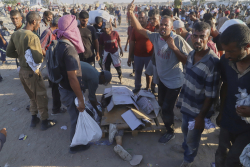Before refugees return, Syria’s new government needs a plan backed by robust international funding, monitoring, and political support.
In recent months, the question of when Syria will be prepared to receive millions of displaced citizens has gained prominence in European political discourse. Following the fall of the Assad regime and the formation of a transitional government led by Ahmed al-Sharaa, several EU states, responding to domestic pressures, have begun suspending asylum claims and considering the deportation of Syrian refugees.
With roughly 14 million Syrians displaced worldwide, including 6 million in neighboring countries and Europe, the urgency is clear. The emergence of Hay’at Tahrir al-Sham (HTS) governance, promising elections and minority protections, coupled with the elimination of certain US and EU sanctions, has bolstered claims that Syria is now safe for return. Yet, the critical question remains: is Syria truly ready for the repatriation of its displaced population?
Assessing the Reality for Refugees
Since Assad’s fall, UNHCR data indicate that nearly 500,000 Syrians have returned from neighboring countries. However, despite HTS’s commitments, these returnees face persistent challenges: ongoing insecurity, sporadic violence, devastated infrastructure, and inadequate public services remain widespread. Economic instability and housing shortages further complicate reintegration efforts, casting doubt on the viability of large-scale returns. This skepticism is echoed in UNHCR surveys, where many in the Syrian diaspora voice concerns over safety and political stability.
Although armed conflict has diminished, Syria’s social and political fabric remains fragile. Premature repatriation could trigger renewed displacement if conditions prove unstable. Any return strategy must be cautious, phased, and based on on-the-ground realities.
Sectarianism and Syria’s Fragile Equilibrium
Although early fears of even more widespread sectarian violence have not come to pass, Syria remains plagued by deep social divisions that continue to threaten stability and hinder the safe return of millions of displaced citizens. The transitional government has made some progress, including the formation of a more inclusive cabinet with Kurdish and Christian representation, the promulgation of a religious fatwa to discourage revenge killings, and the integration of Kurds into national institutions. These steps signal an intention to move toward a more representative and secure Syria.
However, these efforts are not yet sufficient to create the conditions necessary for large-scale repatriation. Targeted attacks on minority communities such as the Alawites and Druze persist, fueled by their perceived association with the Assad regime. The bombing of Mar Elias Church in Damascus, which killed 25 civilians, also highlights a continued threat facing Christians. Additionally, the recent Israeli strikes on Damascus, triggered by the Suwayda clashes between the Druze community and Syrian government forces, underscore how escalating tensions have now drawn Israel into the fray.
In many regions, returnees may find themselves living beside former adversaries or competing for limited resources, a situation that risks reigniting conflict and triggering renewed displacement. Grievances remain unresolved, and what remains of social cohesion is fraying.
True readiness for repatriation depends on more than isolated gestures from the central government. It requires sustained reconciliation at the local level, guarantees of safety and legal protections for minorities, and the restoration of basic services and livelihoods. Without these, returnees will face instability, discrimination, and potential harm, putting both them and hosting countries at risk of violating international humanitarian principles, including the principle of non-refoulement, which prohibits forced return to unsafe conditions.
International support is crucial in preparing Syria for this transition. Gulf states, such as the UAE, Qatar, and Saudi Arabia, have begun to provide aid, and the European Union has pledged € 2.5 billion for stabilization. These resources must be scaled up temporarily and strategically targeted toward community-based peacebuilding, locally driven security efforts, and reintegration programs tailored to Syria’s diverse and divided society.
Funding should prioritize long-term reconciliation mechanisms and empower local actors, with oversight from neutral institutions, such as the UN, to ensure transparency and accountability. This can be done through regular audits, reporting requirements, and monitoring teams embedded at the local level to track implementation and prevent misuse.
Importantly, Syrians themselves must lead the reconciliation process. Local governance should be strengthened, but not dominated by foreign powers, as heavy-handed international involvement could generate resistance or undermine legitimacy. To maintain momentum, continued international aid, particularly for the protection of minority rights, should be made conditional on the transitional government’s adherence to its commitments.
Syria will be ready for repatriation only when clear and verifiable conditions are met. These include consistent security across return areas, functioning legal protections for minorities, community readiness to receive displaced populations without renewed tension, and sufficient infrastructure to support returnees. Until those benchmarks are achieved, repatriation must remain voluntary, gradual, and carefully monitored.
Syria’s Healthand Landmine Crisis
Moreover, Syria’s healthcare system is still in a state of crisis. Devastated by years of war and sanctions that destroyed most of the infrastructure and forced many medical workers to flee. Hospitals and clinics are often understaffed and lack resources, particularly in rural and remote areas where access is severely limited. Meanwhile, NGOs have also reduced operations due to international funding cuts. Without major investment, the fragile system cannot meet the population’s needs or handle increased demand. Compounding the humanitarian emergency is the crisis of landmines and IEDs from the civil war, which have already caused over 1,000 casualties in six months, with children making up nearly one-third of the victims.
While Gulf and EU states can play a vital role in supplying medical equipment, medicines, and technical assistance, long-term recovery must be rooted in Syrian ownership. Sustainable rebuilding depends on local medical personnel being trained, retained, and supported through community-based institutions. To avoid over-dependency, aid must complement, not replace, Syrian capacity. Channeling resources through local health networks, like the Syrian Arab Red Crescent, and regionally grounded partnerships, rather than imposing temporary top-down international programs, will foster greater resilience and accountability over time. Additionally, Syria’s transitional government should collaborate with international donors to develop structures, policies, procedures, and programs aimed at promptly surveying and clearing landmines and explosive remnants of war, as well as securing weapon stockpiles.
If this groundwork is not laid before repatriation begins, the strain on the already fragile healthcare system will only intensify. An influx of returnees without a functioning health infrastructure would overwhelm existing services, make equipment even more scarce, and deepen the humanitarian crisis. To avoid compounding the suffering of displaced populations, healthcare restoration and landmine clearance must be prioritized, not as an afterthought, but as a precondition for any meaningful and dignified return.
Securing Refugee Property Rights
One of the most urgent challenges facing returning Syrian refugees is the absence of secure property rights. The UN Syria Commission reported widespread, systematic looting and destruction of displaced persons’ property, mostly by former government forces, posing a major barrier to safe return and long-term stability.
Further compounding this issue are Assad-era laws such as Legislative Decree No. 66 (2012) and Law No. 10 (2018), which enabled state expropriation of property without due process or compensation. These laws disproportionately targeted displaced populations, many of whom lacked documentation or were unable to meet strict administrative deadlines.
In areas now controlled by HTS, property claims are therefore precarious. A lack of documentation and formal registries leaves returnees vulnerable to dispossession. This deters both individuals and foreign investors, stalling reconstruction and governance efforts. The interim government has not explicitly stated whether it intends to replace Decree 66 or Law No. 10. However, mounting public pressure, legal reviews, and the formation of local committees to amend key decisions suggest a recognition of the laws’ shortcomings and a possible shift toward reform, though no formal repeal has been announced.
Given the scale of displacement and the fragmentation of territorial control, organizing property claims committees solely at the municipal level is insufficient; instead, they should be established regionally or nationally, with international oversight to ensure consistency, legitimacy, and protection of the rights of the displaced.
The conflict in Bosnia and Herzegovina offers a useful model. Following the Dayton Accords, the Commission for Real Property Claims of Displaced Persons and Refugees (CRPC) resolved property disputes with international legitimacy and binding authority. A similar neutral, internationally backed property claims commission could help Syria address property disputes and support returns. To facilitate this, the international community can provide technical expertise, funding, and monitoring to ensure the commission operates transparently, fairly, and independently of political influence.
Rebuilding efforts must also focus on housing, services, and livelihoods to ease tensions and prevent resource-based conflicts. Donors and investments, especially from Europe and the Gulf, should support inclusive community development and minority housing protections to ensure a sustainable return policy.
Preconditions for Safe and Sustainable Repatriation
So, when will Syria be ready to welcome home its displaced population? The answer lies in meeting a set of interdependent conditions: demonstrable minority protections and reconciliation, a resilient healthcare system supported by sustained humanitarian aid, clearance of explosive remnants, and secure, enforceable property rights. Only once these pillars are firmly established can repatriation proceed safely and sustainably.
A phased, meticulously coordinated repatriation plan, backed by robust international funding, monitoring, and political support, is essential to avoid premature returns that risk reigniting conflict and producing new displacement. Through such a careful, collaborative approach, Syria can begin to chart a path toward stability and a future where displaced Syrians can return with dignity and security.
As part of this process, the European Union should develop a comprehensive and carefully designed repatriation plan. Any development aid or sanctions relief linked to repatriation should be conditioned on demonstrable progress toward clearly defined benchmarks. In addition, the European Union should establish a civilian monitoring mission under UN auspices to oversee the return process, document human rights violations, and engage with Syrian civil society to ensure transparency and accountability. These measures are crucial to preventing premature returns that could result in renewed displacement or trigger political backlash within European Union member states.
About the Author: Ivar Jansen
Ivar Jansen was a summer intern at the Center for the National Interest’s Middle East Program. He is a student at the Vrije Universiteit Amsterdam.
Image: Mehmet Ali Poyraz / Shutterstock.com.


















